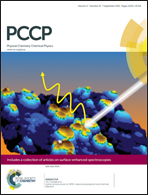Interaction preferences between nucleobase mimetics and amino acids in aqueous solutions†
Abstract
Despite the paramount importance of protein–nucleic acid interactions in different cellular processes, our understanding of such interactions at the atomistic level remains incomplete. We have used molecular dynamics (MD) simulations and 15 μs of sampling time to study the behavior of amino acids and amino-acid sidechain analogs in aqueous solutions of different mimetics of naturally occurring nucleobases, including dimethylpyridine (DMP) and unsubstituted purine and pyrimidine rings. By using structural and energetic analysis, we have derived preference scales for the interaction of amino acids and their sidechain analogs with different nucleobase mimetics and have exhaustively compared them with each other. A close correspondence with a standard hydrophobicity measure in the case of the pyrimidine mimetic DMP and purines suggests that the hydrophobic effect is the main defining factor behind such interactions. We analyze our findings in the context of the origin of the genetic code and the recently proposed cognate mRNA–protein complementarity hypothesis. Most importantly, we show that unsubstituted purine and pyrimidine rings alone cannot differentiate between predominantly purine- and pyrimidine-coded amino acids, suggesting that for such specificity to exist, it must primarily reside in ring substituents.


 Please wait while we load your content...
Please wait while we load your content...